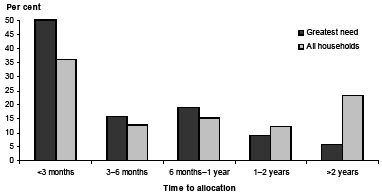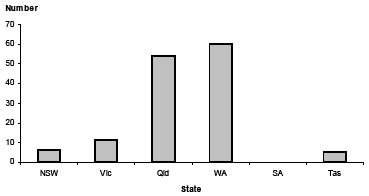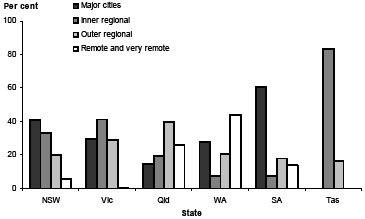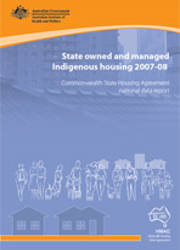Summary
Overview of state owned and managed Indigenous rental housing in 2007-08
State owned and managed Indigenous housing (SOMIH) is provided by six jurisdictions. The Australian Capital Territory does not have a separately identified Indigenous housing program and Indigenous Australians are housed as part of the public rental housing program. All Indigenous-specific housing programs in the Northern Territory are community managed and administered and it is not possible to differentiate between the various funding sources. Indigenous households are also accommodated in all jurisdictions through the mainstream public rental housing program—in 2007-08 this included a further 23,953 households (AIHW 2009).
Households in state owned and managed Indigenous rental housing at 30 June 2008
In total, 12,375 households lived in state owned and managed Indigenous housing at 30 June 2008.
Of all 12,375 households, 10,261 (83%) received a rental rebate. That is, they paid less than market rent for the dwelling (referred to hereafter as 'rebated households'). The remaining 2,114 households (17%) paid market rent. Of the 10,191 rebated households for which complete rent and income details were known, almost two-thirds (63%) paid more than 20% but no more than 30% of their income in rent, while around one-third (35%) paid 20% or less of their income in rent.
The average weekly rental subsidy for rebated households for the week of 30 June 2008 was $112 per household.
Of the 11,440 households occupying SOMIH dwellings for which tenancy composition and dwelling details were known, 1,389 (12%) were moderately overcrowded and 774 (7%) were overcrowded (that is, required one additional bedroom or at least two additional bedrooms, respectively1). A further 2,014 (18%) were underutilised (that is, had two or more bedrooms than were required to meet the standard).
New allocations to state owned and managed Indigenous rental housing during 2007-08
During the period 1 July 2007 to 30 June 2008, 1,294 new households were assisted with state owned and managed Indigenous housing. Of these households, 388 (30%) were classified as being in 'greatest need' (see Section 3.3.6).
Of the 1,284 new allocations for which allocation details were known, 464 households (36%) were allocated housing within 3 months of application and 299 households (23%) were allocated housing 2 years or more after application (Figure 1).
Of the 388 new allocations of SOMIH to households in greatest need, 195 households (50%) were allocated housing within 3 months of application. The proportion of greatest need households allocated housing in a given time period decreases as the time between application and allocation increases, with only 6% still waiting 2 years or more after application (Figure 1).
Figure 1: New allocations of state owned and managed Indigenous housing to households in greatest need and all households, by time to allocation, 2007-08

Source: Table 2.8.
Households waiting for state owned and managed Indigenous rental housing at 30 June 2008
A total of 10,726 households were on waiting lists for state owned and managed Indigenous rental housing at 30 June 2008, of which 965 households were classified as being in 'greatest need'. This represents 9% of all households on waiting lists.
State owned and managed Indigenous rental dwellings at 30 June 2008
In total, state government agencies owned and managed 12,778 Indigenous rental dwellings at 30 June 2008, of which 12,374 were occupied. This represents an occupancy rate of approximately 97%.
Of all 12,778 dwellings, 205 (2%) were untenantable or undergoing major redevelopment, while the remaining 12,573 (98%) were considered tenantable. Figure 2 provides a breakdown of untenantable dwellings by state.
Figure 2: Untenantable state owned and managed Indigenous rental dwellings, by state, 30 June 2008

Source: Table 2.1.
Figure 3 provides the Australian Standard Geographical Classification (ASGC) of remoteness of these dwellings, broken down by state. Nationally, 33% of all state owned and managed Indigenous rental dwellings were located in Major cities, 24% were located in Inner regional Australia, 25% were located in Outer regional Australia, and 18% were located in Remote or very remote areas of Australia.
Figure 3: State owned and managed Indigenous rental dwellings, by Australian Standard Geographical Classification of remoteness, by state, 30 June 2008

Source: Table 2.1.



